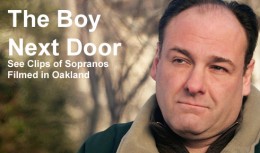 The passing of James Gandolfini has left an empty feeling in many hearts, but only because he filled hearts so readily.
The passing of James Gandolfini has left an empty feeling in many hearts, but only because he filled hearts so readily.
The role many people will forever associate with Gandolfini is that of Tony Soprano, mob boss – and Gandolfini made us love Tony.
Tony was the boy next door who grew up, stayed close to home, got married, raised a family. We shared the normal suburban life he lived, raking leaves, hauling crap out of the basement, kids in trouble, worries, fears, joys, laughs… and we reveled in the excitement of his criminal enterprise.
James Gandolfini, the man, was also the boy next door. The kid from Jersey who crossed the GWB to take on the big city – and he did, in a very big way. Please click here for a New York Daily News tribute to the life of James Gandolfini told in text and images.
Oakland, NJ was also the location for an episode of The Sopranos entitled “College”. At the time, this episode was rated as the best of the series by Time magazine, and was ranked #2 on TV Guide’s list of “TV’s Top 100 Episodes of All Time”.
In this episode, Tony and his daughter Meadow have some serious, personal conversations as he drives her to college. Unfortunately, Fabian Petrulio is tracking Tony and his daughter and follows them back to the roadside motel – (Ramapo Motel in Oakland). Only the presence of two elderly bystanders prevents Petrulio from taking a shot at an unsuspecting Tony.
Series creator, David Chase, has stated that when HBO first read the script, they objected to Tony’s murder of Febby. Executives said that Chase had done so well in building Tony up as a sympathetic character that they believed if Tony committed such a cold-blooded killing, fans would turn on him and the show would lose its protagonist.
Chase said that he believed fans would turn on Tony if the character didn’t commit murder because the omission would make him appear weak.Eventually, Chase won the decision and the episode has become a fan favorite.
Chase named this as his favorite episode because of its self-contained nature. James Gandolfini and Jamie-Lynn Sigler similarly cite this installment.
